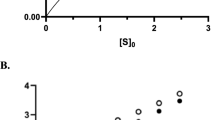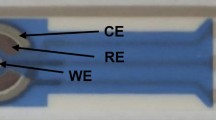Abstract
IN a recent paper, Wilbur and Anderson1 have compared the electrometric and colorimetric methods of determining carbonic anhydrase activity. They have confirmed an observation first made by Kiese and Hastings2 that indicators can inhibit the enzyme and introduce a source of error into the Philpot and Brinkman techniques. They maintain, therefore, the superiority of the electrometric method. However, it must be pointed out that any procedure which is based on measurements of the time taken to bring about a given change in pH, in the presence and absence of the enzyme, is much less reliable than the original manometric method of Meldrum and Roughton3. Experiments carried out in this laboratory have indicated that the electrometric method of following the pH changes is unsatisfactory when different substances are being tested for activating effects. Some of the errors are almost certainly due to interference with the rapid establishment of equilibrium between the glass electrode and the medium. Besides, there is always the possibility that the effects of activators and inhibitors depend on the pH at any given instant. For example, in a 4-ml. solution containing 4·5 units of carbonic anhydrase (activity = 160 units per mgm.), bromothymol blue at a concentration of 2·5 mgm. per cent inhibits by more than 45 per cent at pH 6·8 but only by 25 per cent at pH 7·5. It is suggested, therefore, that the 'boat' method must remain the standard procedure, particularly in work dealing with activators and inhibitors.
This is a preview of subscription content, access via your institution
Access options
Subscribe to this journal
Receive 51 print issues and online access
$199.00 per year
only $3.90 per issue
Buy this article
- Purchase on Springer Link
- Instant access to full article PDF
Prices may be subject to local taxes which are calculated during checkout
Similar content being viewed by others
References
Wilbur and Anderson, J. Biol. Chem., 176, 147 (1948).
Klese and Hastings, J. Biol. Chem., 132, 281 (1940).
Meldrum and Roughton, J. Physiol., 80, 113 (1934).
Mitchell, Pozzani and Fessenden, J. Biol. Chem., 160, 283 (1945).
Scott and Mendive, J. Biol. Chem., 139, 661 (1941).
Author information
Authors and Affiliations
Rights and permissions
About this article
Cite this article
CLARK, A. Determination of Carbonic Anhydrase Activity. Nature 163, 562–563 (1949). https://doi.org/10.1038/163562a0
Issue Date:
DOI: https://doi.org/10.1038/163562a0
This article is cited by
-
Histochemische Untersuchungen über die Carboanhydrase-Aktivität der Rattenplacenta
Pflügers Archiv - European Journal of Physiology (1965)
Comments
By submitting a comment you agree to abide by our Terms and Community Guidelines. If you find something abusive or that does not comply with our terms or guidelines please flag it as inappropriate.



